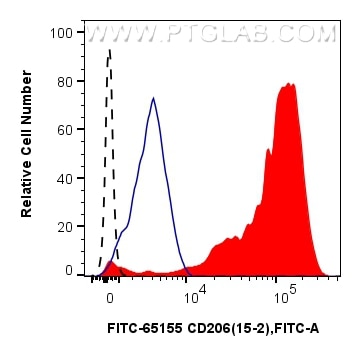Tested Applications
| Positive FC detected in | GM-CSF treated human PBMCs |
Recommended dilution
| Application | Dilution |
|---|---|
| Flow Cytometry (FC) | FC : 5 ul per 10^6 cells in 100 μl suspension |
| This reagent has been pre-titrated and tested for flow cytometric analysis. The suggested use of this reagent is 5 µl per 10^6 cells in a 100 µl suspension or 5 µl per 100 µl of whole blood. | |
| Sample-dependent, Check data in validation data gallery. | |
Published Applications
| FC | See 14 publications below |
Product Information
FITC-65155 targets CD206 in FC applications and shows reactivity with human samples.
| Tested Reactivity | human |
| Cited Reactivity | human |
| Host / Isotype | Mouse / IgG1, kappa |
| Class | Monoclonal |
| Type | Antibody |
| Immunogen |
Purified human mannose receptor Predict reactive species |
| Full Name | mannose receptor, C type 1 |
| Calculated Molecular Weight | 166 kDa |
| GenBank Accession Number | NM_002438 |
| Gene Symbol | CD206 |
| Gene ID (NCBI) | 4360 |
| RRID | AB_2920499 |
| Conjugate | FITC Plus Fluorescent Dye |
| Excitation/Emission Maxima Wavelengths | 495 nm / 524 nm |
| Form | Liquid |
| Purification Method | The purified antibody is conjugated with fluorescein isothiocyanate (FITC) under optimum conditions. The conjugate is purified by size-exclusion chromatography. |
| UNIPROT ID | P22897 |
| Storage Buffer | PBS with 0.09% sodium azide and 0.5% BSA, pH 7.3. |
| Storage Conditions | Store at 2-8°C. Avoid exposure to light. Stable for one year after shipment. |
Background Information
CD206, also named as MMR, CLEC13D and MRC1, is a type I membrane receptor that mediates the endocytosis of glycoproteins by macrophages. CD206 has been shown to bind high-mannose structures on the surface of potentially pathogenic viruses, bacteria, and fungi so that they can be neutralized by phagocytic engulfment. CD206 is a 170 kDa transmembrane protein which contains 5 domains: an amino-terminal cysteine-rich region, a fibronectin type II repeat, a series of eight tandem lectin-like carbohydrate recognition domains (responsible for the recognition of mannose and fucose), a transmembrane domain, and an intracellular carboxy-terminal tail. It is expressed on most tissue macrophages, in vitro derived dendritic cells, lymphatic and sinusoidal endothelia.
Protocols
| Product Specific Protocols | |
|---|---|
| FC protocol for FITC Plus CD206 antibody FITC-65155 | Download protocol |
| Standard Protocols | |
|---|---|
| Click here to view our Standard Protocols |
Publications
| Species | Application | Title |
|---|---|---|
Biochim Biophys Acta Mol Basis Dis Extracellular ATP (eATP) inhibits the progression of endometriosis and enhances the immune function of macrophages | ||
Front Immunol Chamaejasmenin B, an Inhibitor for Metastatic Outgrowth, Reversed M2-Dominant Macrophage Polarization in Breast Tumor Microenvironment. | ||
Biol Direct The role of SH3RF2 in lung squamous cell carcinoma and M2 polarization: insights into LZTS2 ubiquitination | ||
Front Oncol Itraconazole inhibits the Wnt/β-catenin signaling pathway to induce tumor-associated macrophages polarization to enhance the efficacy of immunotherapy in endometrial cancer | ||
Pharm Biol Schizandrin A ameliorates cognitive functions via modulating microglial polarisation in Alzheimer's disease mice. | ||
J Biochem Mol Toxicol MYCN/MNX1 Axis Drives NSCLC Progression by Inducing Macrophage M2 Polarization and CD8+ T Cell Apoptosis via the Wnt/β-Catenin Pathway |




